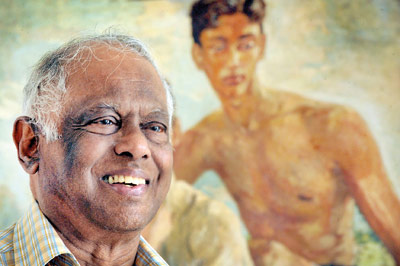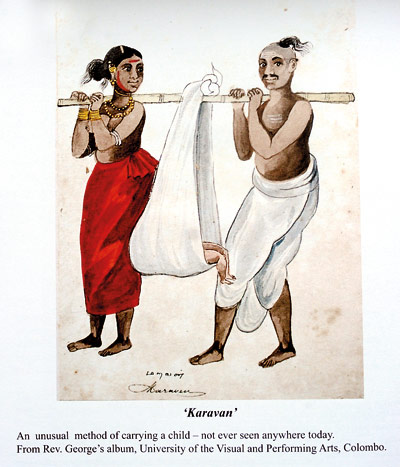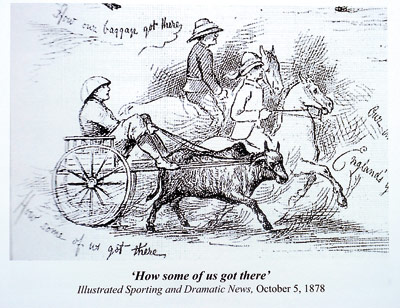Making a mark with old prints
Dr. Rajpal (R.K.) de Silva opens the door to his second floor flat off Jawatte Road to usher us in. Even the casual visitor to the apartment should have no trouble identifying the interests of her/his host.

Dr. R.K. de Silva, and below some of the illustrations in his book. Pix by Amila Gamage
The walls are covered with paintings, many by de Silva’s mother. (In one he is only 16 years old, thin and long-necked; in another self-portrait, his mother stands alongside his sisters.)
There are books everywhere but on the sofa, spilling out of their packaging, are a set so recently published that they still smell of the printers.
These same books made their way down to the Dutch Burgher Union this week for a launch that celebrates not one but two new additions to de Silva’s series ‘Pictorial Impressions of Early Colonial Sri Lanka.’
He curated and co-wrote the collection on ‘Religions and Rituals’ with Albert Dharmasiri and that on ‘Travel and Transportation’ with Ranjan Gooneratne.
A dedicated collector of antique books and prints, de Silva divides his time between Sri Lanka and Britain, where he and his wife have a home in London.
Having retired from a long career as a paediatrician in England, he has become one of Sri Lanka’s most dedicated archivists.
His first publication ‘Early Prints of Ceylon – Sri Lanka, 1800 – 1900’ published in 1985 remains one of the most comprehensive of that period to be ever produced and he added to that work with ‘Illustrations and Views of Dutch Ceylon, 1602 – 1726’, ‘19th Century Newspaper Engravings of Ceylon,’ and ‘Maps and Plans of Dutch Ceylon’. He has already released two books in his Pictorial Impressions series: ‘People and Dress’ and ‘Customs and Occupations.’
Now, flipping through the edition on ‘Travel and Transportation’, de Silva explains that a significant part of the visual record of Sri Lanka in the 19th century consists of illustrations published in travel folios, books, newspapers and magazines.
These “pre-camera images” are fascinating to him for the insights they provide into the beauty of the island’s flora and fauna, the customs of its people, their occupations, dress and religious ceremonies.
“They’re pretty accurate,” he says of the images. “Although the artists were amateur, especially in the Victorian era and in places like England, many were able to reproduce what they saw.”
The watercolours in particular are very fine, note the authors describing the transition from a time where everyone sailed, rode or simply walked wherever they needed to go, to after the invention of the wheel when a fascinating array of vehicles took to the streets.
The book records these simpler forms of travel, dedicating its earliest pages to an assortment of images of people carrying things: jakfruits, bales of hay, plantains, fish and even babies.
From Society in Mediaeval Ceylon, we have the familiar image of a pingo or kada which villagers put to diverse uses and which can still be seen on Sri Lankan roads.
Another set of images is of bridges, roads and pathways which the authors note were not always well maintained depending on the politics of the country’s rulers: ‘There is no doubt that with foreign nations knocking at their door, the Sinhalese kings ceased to improve means of communication in the island and allowed the existing roads to fall into disuse,’ they write, adding,‘Indeed, it was at one time a serious offence to cut a track through the forest as it might jeopardise the security of the King’s strongholds.’
We see Colombo through the eyes of Egyptian pashas and Nobel Prize winning physicists (their accounts were published in newspapers and journals of the day) and hear of the Colombo to Kandy mail coach – the first of its kind in Asia – that began running between the two cities in 1832 and of the ‘bullock mail’ which was its competitor from 1849 onwards.
The images then turn to the earliest days of Ceylon Railways followed by a large collection of images relating to sailing and fishing.
This last section is dense with portraits of life in Sri Lanka, from the humble catamarans hauling the day’s catch home to the warships that docked in the island’s harbours.
In ‘Religions and Rituals’, de Silva and Dharmasiri produce another volume that offers both aesthetic value and intellectual gratification, pairing as it does interesting accounts from the historical record with beautiful images.
Noting that Buddhism and Hinduism were introduced to the island in the 2nd Century BC, the authors trace the arrival of Islam a few centuries later, followed by Christianity in the 16th century.
Considering this history of religious diversity, they begin the book with a selection of views of Adam’s Peak. Many depict the mountain from a distance, its sacred peak wreathed with significance.
Among the images inspired by Buddhism are panels from the Jataka stories, and images of the sacred Bo tree. Hinduism provides the images for a slim section populated primarily with ornate temples in Trincomalee; Islam brings mosques and imams, and Christianity, churches.
The section of the book dedicated to rituals is populated with demons and gods and includes pages devoted to astrology and traditional masks.
“We Sri Lankans don’t really have an ethic of collecting images,” says de Silva. He himself is uncertain why he came to be so devoted to this pursuit, but suspects his mother’s love for art had a role in inspiring him.
Among his collection he has enough to produce more volumes on Flora and Fauna but admits ruefully that he feels his age catching up to him.
Though the series of Pictorial Impressions may very well end with these two publications, de Silva himself is determined to produce at least one other book. (He hopes his memoirs of his time as a doctor will encourage young medical students to apply dedication and scrupulous care to their profession.)
Whatever comes next for the author, even if this series were to never go beyond these two last books, de Silva can take pride in having made a significant contribution to Sri Lankan scholarship.


